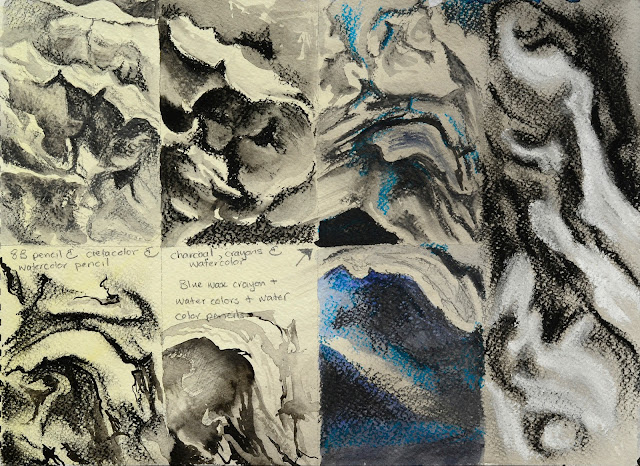 |
Fig. 1. Thumbnail sketches of mini succulent gardens.
|
 |
| Fig. 2. Succulent study using varying media in sections. |
This lead me to believe that it would be better for me to revert to working with my original thistle idea. I washed the surface of the sketchbook with strokes of charcoal grey. I stuck a museum ticket pass as a connection to the history of this region, and some tissue paper onto the surface of the sketchbook. Next, I tried a zoomed in section of the stem and seeds of a thistle plant, experimenting with various media. What I did not like was how the acidic lemon used in the thistle tufts created a disturbing class with the predominantly blue greys of the rest of the thistles.
 |
Fig. 3. Sketchbook study of section of thistles
|
At this stage, I decided to make my study more about the negative space in between the spines of the thistles, rather than the thistles themselves. I like the detail of the shapes of the negative spaces, but at this stage, I felt that this idea was too simplistic as I had done a similar exercise with my seven and eight-year-old class at my previous school (Fig.4.). So, instead, I reverted to studying the bark that I had collected and to allow my imagination to further develop these studies into a more abstract approach to the subject matter.
 |
| Fig. 4. Negative space study in sketchbook |
 |
Fig. 5. Gridded studies of bark - sketchbook
|
 |
| Fig. 6. Close up study of a piece of bark. |
I think that this style of working has potential. I would like to experiment with warmer tones, instead of the blues as the wood I am working with is essentially warm in tone. This study looks more like a study of bones due to its hue range.
!7 November, 2016
I discussed this sketch with Montenegrin artist, Mirjana Maresenic Vujovic, and she particularly liked the fact that the original blue wash still peaks through the dark bachground. She pointed out how crucial this tiny splash of intense blue is to the balance of the whole composition. Her feeling is that this sketch has potential to be developed into a large, abstract study.
!7 November, 2016
I discussed this sketch with Montenegrin artist, Mirjana Maresenic Vujovic, and she particularly liked the fact that the original blue wash still peaks through the dark bachground. She pointed out how crucial this tiny splash of intense blue is to the balance of the whole composition. Her feeling is that this sketch has potential to be developed into a large, abstract study.
No comments:
Post a Comment